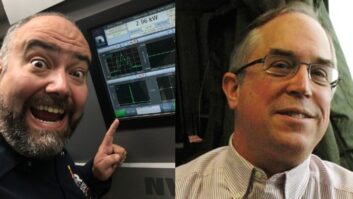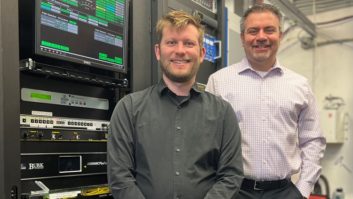The following is excerpted from the upcoming book, “Audio over IP — Building Pro-AoIP facilities with Livewire” by Steve Church and Skip Pizzi. ISBN # 9780240812441, to be published this month by Focal Press Inc.
5.1.1 Simplification via Cabling
An important goal for AoIP is to simplify installations that would otherwise be burdened with the complexity of the variety of cables, connectors, and wiring styles that have proliferated over the years as new technologies for audio routing and transport have appeared. We’ll show you how it is possible to use a common and standard cable and plug approach for everything in your plant. This goal can be achieved even when analog and AES3 components are part of an AoIP installation.

5.1.2 Structured Wiring
When you need to build a big plant, this is the way to go. In the old days, wiring was specific to the task, and often to the vendor. Each telephone, network, and audio had its own cable type and wiring protocols.
Today things are different. The idea at standards bodies like the Telecommunications Industry Association (TIA) and the Electronic Industries Association (EIA) is to define classes or categories of cables and accessories that can be used for all applications specified for that class. With this approach, you have a vendor-independent way to wire buildings and facilities, so that services from many vendors can be supported over time without replacing cabling and connectors. The name for this concept is structured wiring. The model encompasses both specification of the cabling components and the way in which they are installed.
Since structured data network cabling is standardized and widely deployed, outside contractors can install and test your cabling without having any specialist knowledge in broadcasting or pro-audio.
5.1.3 Ethernet for AoIP Systems
AoIP systems primarily use copper cables. By far, the two most common Ethernet transport technologies for AoIP on copper are 100Base-T and 1000Base-T (often called “gigabit Ethernet”).
100Base-TX
Although often called 100Base-T, the current, official name for 100 Mbps Ethernet is 100Base-TX, and it is the baseline for AoIP, using copper cables with RJ-45-style plugs and jacks. It is well matched to connections from Livewire audio nodes to switches since the 100 Mbps bandwidth is plenty for up to 25 send and receive stereo audio channels.
100Base-TX Ethernet is balanced and transformer coupled, so it has very good resistance to interference, and has no problem with ground loops.
1000Base-T
Mixing/processing engines serve a lot of audio channels, so a step up in bandwidth is required for them. 1000Base-T, providing 1 Gbps bandwidth, is the usual choice. PCs are routinely connected this way as well. And switch-to-switch connections are almost always gigabit, using either 1000Base-T or fiber.
The main reason to move away from the two copper mainstays is if you wanted to mix in some fiber where it made sense to do so, such as for long runs. Note that there are other possibilities as well — dozens of Ethernet media types that have been standardized—but only a few are in wide use. Table 5.1 summarizes the principal options to be considered for AoIP applications.
The length numbers are the official ones and are conservative. The full-duplex operation that AoIP uses permits even longer runs. (In a single-duplex operation, the propagation time for Ethernet’s collision-detection mechanism needs to be taken into account, but AoIP’s full-duplex operation never has collisions.)
Ten-gigabit Ethernet (10-GbE) is an emerging technology, used mostly to interconnect large IP routers. There are more than 10 standards vying for acceptance. As this is being written, 10GBase-LR and -ER have the most common usage.

On the horizon are 40- and 100-gigabit Ethernet. Standards are being formulated and some products are coming to market now.
5.1.4 Twisted-Pair Cable Categories
Cable categories (usually abbreviated “Cat n“) are fundamental to the structured wiring concept. The cabling specifications for the various categories are in the TIA/EIA-568-A (and -B) Commercial Building Telecommunications Cabling Standard.
The most significant differences between cables from each category are the number of twists per foot, and the tightness with which the twists and spacing of the pairs to each other are controlled. The wire pairs in a Category 3 (Cat3) cable usually have two twists per foot and you may not even notice the twists unless you peel back quite a lot of the outer insulation. Cat5 is twisted around 20 times per foot. Cat6 has even tighter twisting. Each step up results in better crosstalk performance, with the benefit becoming increasingly important as the data frequency rises.
Here’s a rundown:
- • Cat3: Pretty much obsolete for data applications, these are used only for voice-grade telephony and Ethernet 10Base-T.
- • Cat5: This designation applies to 100-Ω unshielded twisted-pair cables and associated connecting hardware of which the transmission characteristics are specified up to 100 MHz. Cat5 cables support Ethernet 100Base-TX.
- • Cat5e: This is enhanced Cat5 cable. It is quite widely deployed today because it supports both 100Base-TX and gigabit (1000Base-T). It is probably the minimum recommended for an AoIP installation.
- • Cat6: This provides significantly higher performance than that of Cat5e. This cable has a plastic pair separator inside that holds the wires in correct relation to each other. For this reason, Cat6 cables are larger in diameter than Cat5 cables. Cat6 is preferred for 1000Base-T, but not required. Cat6 is a good idea for new AoIP installations that need to be future-proof, require maximum reliability, and can absorb the cost increment.
Another characteristic of cables that needs to be considered is the insulation material. “Plenum-rated” cables are more stable with changing temperatures due to their use of Teflon rather than PVC insulation. Plenum-rated cables are required in air-handling spaces in order to meet fire regulations. Teflon produces less smoke and heat than PVC in the case of a fire, and does not “support” the spread of flames.
Printed with permission from Focal Press, a division of Elsevier. Copyright 2010. “Audio Over IP, Building Pro AoIP Systems with Livewire” by Skip Pizzi and Steve Church. For more information about this book and other similar titles, please visitwww.focalpress.com.












